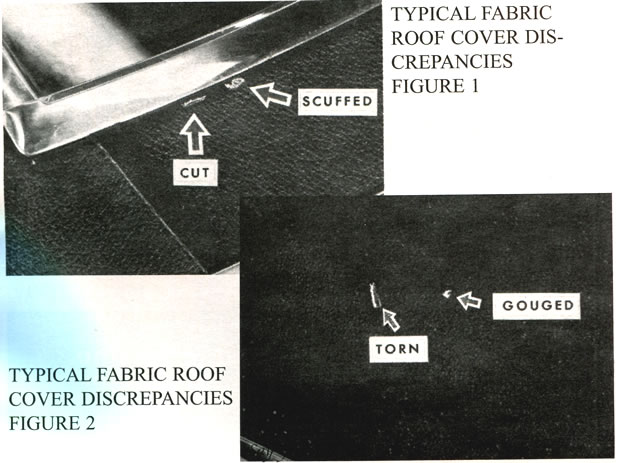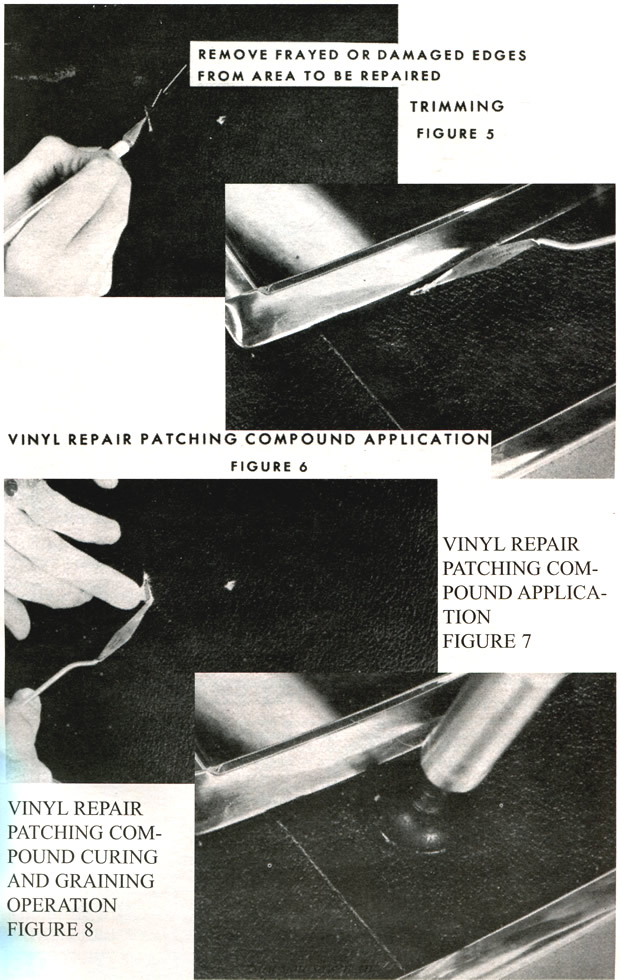
The following bulletin is excellent information for repairing 1967 - 1975 Corvette vinyl covered auxiliary hardtops!
Subject: Fabric Roof Cover Repairs
Model and Year: NA
Source: Chevrolet Dealer Service Information Bulletin
Bulletin No: 69-I-2 (Supplement)
Section: I
Date: July 18, 1969
TO: ALL CHEVROLET DEALERS
This bulletin is being written to supplement Chevrolet Dealer Service Information Bulletin 69-I-2.
This supplement describes an improved procedure for the repair of fabric roof covers. Certain types of damage that previously required replacing the fabric roof cover may now be repaired by using the methods and tools described in this bulletin.
Chevrolet Motor Division
General Motors Corporation
TOOLS AND REPAIR MATERIALS DESCRIPTION
1. Fabric Roof Cover Repair Tool J-23091 (Figure 3) - for curing and graining vinyl repair patching compound.
2. Pallet Knife (Figure 4) - a small trowel used for applying vinyl repair patching compound (available at artist supply stores).
3. Razor/Knife (Figure 4) - a sharp knife used for removing frayed edges from damaged area prior to application of vinyl patching compound (x-acto or equivalent available at hobby shops).
4. Vinyl Cleaner (Detergent Type) - all purpose cleaner for removal of surface dirt, grease, dust, etc., from extremely dirty roof covers (Kar-Kleen, Joy, Tide, car wash soaps, etc., that do not leave a residue.)
5. Vinyl Cleaner (Solvent Type) - for removal of wax, silicone, oil, etc., from repair area prior to paint application (use Rinshed-Mason "Pre-Kleano", DuPont "Prep-Sol", Ditzler "Acryli-Clean" or equivalent).
6. Vinyl Repair Patching Compound - a heat curing milky appearing heavy bodied plastisol for repairing cut, torn, scuffed or gouged vinyl roof cover material (Fabric Roof Cover Repair Patching Compound is available through Rinshed-Mason under Stock No. 863; through Uticolor Laboratories, Inc., under Stock No. PC-1; and through Detroit Autobody Equipment Company, under Stock No. PCV-Vinylweld.
7. Vinyl Repair Paint - a durable waterproof weather resistant and pliable vinyl coating for refinishing vinyl coated fabrics. Vinyl color finishes are available in 16 ounce aerosol and in one quart containers as outlined below:

REPAIR PROCEDURE
(Before attempting repairs on a vinyl roof cover, it is recommended that several repairs be made on a piece of scrap vinyl cemented to a metal panel to familiarize the operator with the procedures outlined in this bulletin.)
1. Pre-Heat Fabric Roof Cover Repair Tool J-23091 (Figure 3) - using a basic 72 setting (plus or minus two: 70-74 setting) on the variable heat control (Tool J-23091-3), pre-heat Tool J-23091 for a minimum of 15 minutes until the graining tool achieves an operating temperature of approximately 300 degrees.
2. Surface Preparation
3. Vinyl Patching Compound Application
4. Graining Operation - Exerting light hand pressure, apply pre-heated graining iron to damaged area filled with patching compound for approximately one and one-half (1-1/2) minutes as shown in Figures 8 and 9. Curing and graining time can be increased slightly depending on the size of the repair.
IMPORTANT : During this operation, it is important the graining iron be held in a stable, perpendicular position.
NOTE: Use the surface of the tool most compatible to the damaged area contours (round edge in drip rail areas; tapered edge adjacent to reveal moldings; crown surface for relatively flat areas). For large damaged areas, repeat curing and graining, using an over-lapping technique.
5. Color Application
6. Tool Clean-Up
Upon completion of repairs, clean graining tool with a soft cloth and a solvent type vinyl cleaner to remove any top coating stuck to the surface of the tool. This is particularly important when working on different color roof covers.




Article ID: 1121
Created: January 22, 2015
Last Updated: January 23, 2015
Online URL: https://www.corvetteactioncenter.com/tech/knowledgebase/article/1967-1975-corvette-service-bulletin-fabric-roof-cover-repairs-1121.html